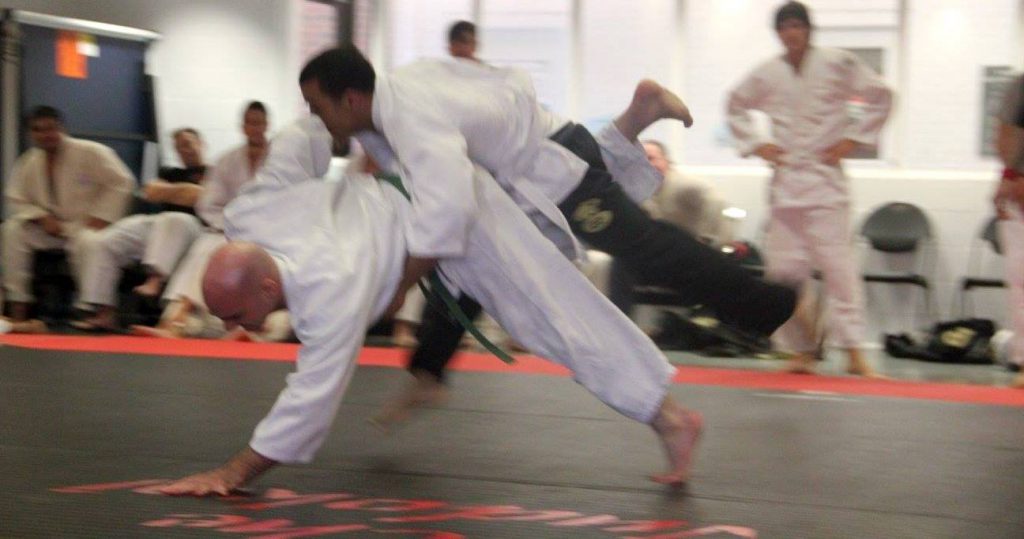
Kachinuki Shiai – Can you survive an UNFAIR tournament?

Kachinuki / Kohaku Shiai
(Old Style Tournaments)
What is a Kachinuki or Kohaku Shiai and why does The Judokai use this format for Fight Club?
The following excerpt taken from “Traditions: Essays on the Japanese Martial Arts and Ways” by Dave Lowry explains it well.
/–
A few decades ago, the idea of shiai, or contests, in karate, judo, and kendo was quite different than it is today. The emphasis then was on an interaction between various dojo. Members got to see and experience the techniques used by others, methods taught in other schools. There was also a great deal of social interaction. Martial arts contests were almost always followed by potluck dinners and informal parties. Many budoka of non-Japanese ancestry got their first taste of sushi, sashimi, and other Japanese food after these shiai back in the sixties, made by mothers, wives, and girlfriends of contestants. Oh, and one other thing about those shiai that distinguished them from today’s matches: there were, technically speaking, no winners.
It sounds odd, a contest with no winners. But here is the way a kachinuki type shiai worked. Beginning at the shimoseki (literally, the “lower side”) of the tournament hall (which is called shiaijo, by the way), the contestants would line up with the lowest ranks beginning a the left, all the way up to the black belts at the joseki (“upper side”). The matches began with the white belt at the farthest left–at the first of the line, in other words–facing the fellow on his right. Let’s call them A and B. Let’s say A won. B would sit back down, and the fellow on his right, C, would be next to face A. That’s right, A; the guy who just fought and is still winded. But he’s lucky; he wins against C too. What happens? C sits down and D jumps up to take on A. Now you’re beginning to get the idea of kachinuki shiai. You stay up and fight as long as you win. Beat five guys in a row and your reward is to face the sixth. No semifinals, no double eliminations; just fight and win or lose and sit down.
At first, kachinuki may seem like a very unfair way to run an athletic contest. After all, it is a given that the guy who’s just won three matches in a row is going to be exhausted. He will be facing opponents who have been sitting and are rested. Ah, but, there’s one little detail I haven’t mentioned. Those guys waiting their turn were sitting, waiting their turn in the line to fight. But they were not sitting any way they liked. They were sitting formally, on their knees, legs folded with their heels on their buttocks, in the position of seiza. It is a manner of sitting that, unless you are very accustomed to it, can result in the entire lower half of your body becoming numb in a short time.
No warm-ups, no preparatory “on deck” announcements were part of kachinuki shiai. You knew your turn was coming up when the competitor next to you got up for his match. When your turn came, you had to deal with wobbly, tingling legs. The contestant you would be facing had just fought; he might have been winded, but he would also have had the chance to warm up and loosen his muscles. He would be relaxed and ready to go, and if an approaching opponent wasn’t careful, that opponent was going to be beaten while he was still trying to stretch out his stiffness. Then too, in a large tournament, by the time the matches had worked their way down to the far end of the line, the black belts there may have been sitting virtually motionless for a couple of hours. After that time it was a struggle even to stand up. Many a senior brown belt was able to best his senior in the black belt ranks by taking advantage of his senior’s having been sitting so long he had trouble just getting to his feet, never mind making a good account of himself in competition.
So, do you seen why there were no “winners” in kachinuki competition as we usually think of them? Yes, you may have beaten contestant G, but you were only able to do it after he’d fought and beaten contestants C, D, E, and F, for example. This system made categories like winners and losers mostly meaningless. Egos bloated by championships never had a chance to blossom. Trophies, if given at all, were usually awarded to the dojo which had collectively won the most matches or more likely, to those competitors who showed the best (though not always the winning) spirit.
I do not wish to paint a rosy “everyone just got together and had fun” picture of kachinuki shiai. Contestants fought. Hard. It was my experience that ten minutes after the medals were given out everyone had already forgotten who had received them, true. But we knew who had demonstrated the best technique, who we wanted to face the next time. We also remembered the techniques we saw, the wonderful displays of courage and determination, and the comradeship of the whole event.
I suppose some might continue to insist that a kachinuki-style shiai is unfair. There is not much good argument against that position. Kachinuki shiai is unfair, no doubt about it. It is unfair in the same sense battlefield combat is unfair, or that a real-life self-defense situation is unfair. There are no warm-ups under those circumstances either, or resting periods. Kachinuki shiai is UNFAIR. Which is, as those of us fortunate enough to experience it have learned, a pretty good way to train for the unfairness of much of the rest of life.
—
It is for these reasons that a modified Kachinuki is the style of tournament used by Fight Club at The Judokai.
Can you survive an UNFAIR tournament?


